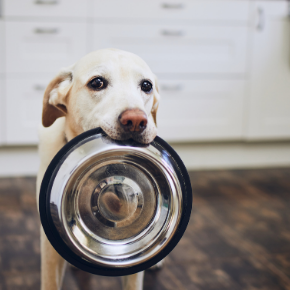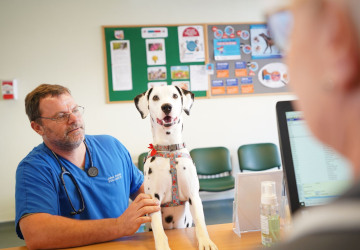
How to feed your dog – everything you need to know
January 14, 2021
It might sound like an odd question, but how do you feed a dog? Don’t you just throw some dog food in a bowl and put it in front of them? According to our head vet Jürgen Theinert, there’s a little more to it than that…
- The right type of food – Opt for a high-quality, commercial complete food, as they’re designed to give your dog all the nutrients they need. DIY, plant-based, and raw diets can all lack the vital nutrients your dog needs to live a healthy and happy life, as can some poor-quality commercial brands. Raw foods are especially concerning as they can contain harmful bacteria and parasites.
- Match food to your dog’s needs – Many commercial complete dog foods are designed to support life stages (puppy, adult, senior), breed size, health conditions, and dietary requirements. If your dog has a health condition, such as kidney disease, talk to your vet about the right type of food for their needs.
- Dry, wet, or both? – Dry kibble will give your dog’s teeth a workout, whereas wet food will add moisture to their diet. You may want to try a combination.
- How much – Canine obesity is common and can reduce quality & length of life. Avoid this and other health issues by consistently giving your dog the right amount of food for their needs. Follow the packet guidelines and weigh your dog’s daily meals. How much they need also depends on activity levels i.e. a working sheepdog will require a lot more food than a less active dog.
- How often – Twice a day is good for small/very active dogs to regulate glucose levels and keep energy up. Three or more smaller meals can benefit dogs who have trouble absorbing nutrients or maintaining weight. ‘Free feeding’ i.e. leaving a day’s worth of food out for grazing, can work for some dogs, however, most (especially puppies) will eat way more than they need.
- Choose good snacks – Give your dog healthy snacks in moderation like carrot, cucumber and apple (not the seeds) and avoid scraps of human foods that will add extra calories and potentially harm them. Fatty and sugary foods can cause serious health issues and some foods are toxic to dogs, such as chocolate.
- Make changes slowly – Avoid health problems and picky eating by changing your dog’s food slowly. Swap a bit of their normal food for the new food, and gradually increase the ratio over 1-2 weeks. Introducing new foods in small amounts should avoid tummy upsets, or at least let you know quickly what to avoid. This includes a complete flavour change if you’ve always stuck to one.
If you’re unsure about what, when, and how much to feed your dog, why not pop onto our Facebook page and ask us any diet related questions?






